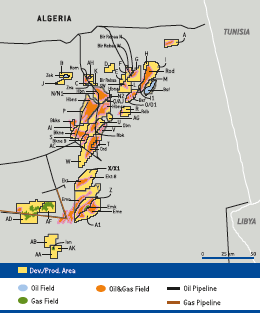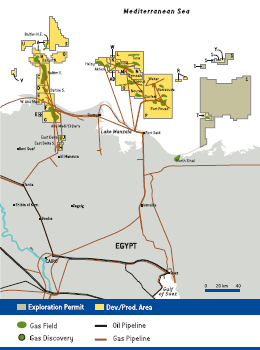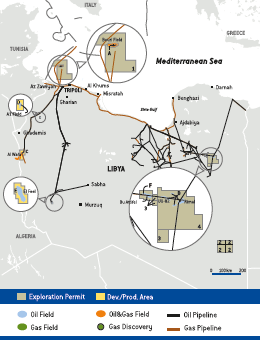North Africa
Algeria
Eni has been present in Algeria since 1981. In 2013, Eni’s oil and gas production amounted to 88 kboe/d. Operated and participated activities are located in the Bir Rebaa area in the South-Eastern Desert: (i) Blocks 403a/d (Eni’s interest 100%); (ii) Block Rom North (Eni’s interest 35%); (iii) Blocks 401a/402a (Eni’s interest 55%); (iv) Blocks 403 (Eni’s interest 50%) and 404 (Eni’s interest 12.25%, non-operated); (v) Blocks 208 (Eni’s interest 12.25%, non-operated) and 405b (Eni’s interest 75%); and (vi) Block 212 (Eni’s interest 22.38%) with discoveries already made.
In 2013 production activities at the Blocks 403 a/d and 403 used technical synergies of R&D Integrated Operations Program leveraging on the Centre of Excellence for Electrical Submersible Pump (ESP).
In particular, leveraging on the real time analysis of performance data at the producing well, operations were performed in time to avoid possible disruptions, with cost and time savings.
Developed and undeveloped acreage of Eni’s interests in Algeria was 3,410 square kilometers (1,179 square kilometers net to Eni).
Exploration and production activities in Algeria are regulated by Production Sharing Agreements (PSAs) and concession contracts.
In the medium term, Eni’s production in Algeria is expected to increase reflecting the development of assets in portfolio.
Blocks 403a/d and Rom North
 Production Production in the area comes mainly from the HBN and Rom and satellite fields and represented approximately 18% of Eni’s production in Algeria in 2013. Production from Rom and Satellites (Zea, Zek and Rec) is treated at the Rom Central Production Facilities (CPF) and sent to the BRN treatment plant for final treatment, while production from the HBN field is treated at the HBN/HBNS oil center at the Groupment Berkine.
Production Production in the area comes mainly from the HBN and Rom and satellite fields and represented approximately 18% of Eni’s production in Algeria in 2013. Production from Rom and Satellites (Zea, Zek and Rec) is treated at the Rom Central Production Facilities (CPF) and sent to the BRN treatment plant for final treatment, while production from the HBN field is treated at the HBN/HBNS oil center at the Groupment Berkine.
Blocks 401a/402a
Production Production from this area is supplied mainly by the ROD/SFNE and satellite fields and accounted for approximately 20% of Eni’s production in Algeria in 2013. Activities are being performed in order to maintain the current production plateau.
Block 403
Production The main fields are BRN, BRW and BRSW which accounted for approximately 14% of Eni’s production in Algeria in 2013.
Block 404
Production The main fields are HBN and HBNS which accounted for approximately 30% of Eni’s production in Algeria in 2013.
Block 405b
Production In 2013, the area accounted for approximately 14% of Eni’s production in Algeria, mainly from the production of MLE-CAFC project, started during the year. The natural gas treatment plant has a production and export capacity of 320 mmCF/d of gas, 15 kbbl/d of oil and condensates and 12 kbbl/d of LPG. Four export pipelines link it to the national grid system. The integrated project MLE-CAFC targets a production plateau of approximately 33 kboe/d net to Eni by 2017.
Development In 2013, the contracts of the development CAFC oil project were awarded. The completion is expected in 2017.
Block 208
Production In 2013, the block accounted for approximately 4% of Eni’s production in Algeria, following the start-up of El Merk field. Production start-up was achieved through the construction of a gas treatment plant for approximately 600 mmcf/d, two oil trains for 65 kbbl/d each and three export pipelines linked to the local network. Production peak of 18 kboe/d net to Eni is expected in 2015.
Development The El Merk development project provides for the drilling of further 25 productive wells.
Egypt
 Eni has been present in Egypt since 1954. In 2013, Eni’s share of production in this country amounted to 227 kboe/d and accounted for 14% of Eni’s total annual hydrocarbon production. Developed and undeveloped acreage in Egypt was 10,386 square kilometers (3,665 square kilometers net to Eni). Eni’s main producing liquid fields are located in the Gulf of Suez, primarily the Belayim field (Eni’s interest 100%), and in the Western Desert mainly the Melehia (Eni’s interest 76%) and the Ras Qattara (Eni’s interest 75%) concessions. Gas production mainly comes from the operated or participated concession of North Port Said (Eni’s interest 100%), El Temsah (Eni’s interest 50%), Baltim (Eni’s interest 50%) and Ras el Barr (Eni’s interest 50%, non operated), located offshore the Nile Delta. In 2013, production from these large concessions accounted for approximately 94% of Eni’s production in Egypt.
Eni has been present in Egypt since 1954. In 2013, Eni’s share of production in this country amounted to 227 kboe/d and accounted for 14% of Eni’s total annual hydrocarbon production. Developed and undeveloped acreage in Egypt was 10,386 square kilometers (3,665 square kilometers net to Eni). Eni’s main producing liquid fields are located in the Gulf of Suez, primarily the Belayim field (Eni’s interest 100%), and in the Western Desert mainly the Melehia (Eni’s interest 76%) and the Ras Qattara (Eni’s interest 75%) concessions. Gas production mainly comes from the operated or participated concession of North Port Said (Eni’s interest 100%), El Temsah (Eni’s interest 50%), Baltim (Eni’s interest 50%) and Ras el Barr (Eni’s interest 50%, non operated), located offshore the Nile Delta. In 2013, production from these large concessions accounted for approximately 94% of Eni’s production in Egypt.
Exploration and production activities in Egypt are regulated by PSAs.
In the next four years Egypt confirms to be one of Eni’s largest oil and gas producing Countries.
Gulf of Suez
Production Production mainly comes from the Belayim field, Eni’s first large oil discovery in Egypt, which produced approximately 105 kbbl/d (56 net to Eni) in 2013.
Development Drilling and infilling activities are in progress in the Belayim area, in order to optimize the recovery of its mineral potential. Other activities included the upgrading of the water injection system at the Abu Rudeis field (Eni’s interest 100%). The level of produced water re-injected is 99.5%, corresponding to approximately 1 mmcf/d.
Exploration Exploration activities yielded positive results with two near field oil discoveries in the Belayim area.
Nile Delta
North Port Said
Production Production for the year amounted to 31 kboe/d (24 net to Eni), approximately 106 mmcf/d of natural gas and approximately 3 kbbl/d of condensates. Part of the production of this concession is supplied to the United Gas Derivatives Co (Eni’s interest 33.33%) with a treatment capacity of 1.3 bcf/d of natural gas, which is increased in the year, and a yearly production of 380 ktonnes of propane, 305 ktonnes of LPG and 1.5 mmbbl of condensates.
Development Ongoing development activities aimed at supporting current gas production.
Baltim
Production In 2013 production amounted to approximately 62 kboe/d (approximately 20 kboe/d net to Eni); approximately 106 mmcf/d of natural gas and 3 kbbl/d of condensates.
Development Ongoing development activities aim at supporting current gas production.
Ras el Barr
Production In 2013, the production amounted to approximately 112 kboe/d (40 net to Eni), mainly gas from Ha’py, Akhen, Taurt and Seth fields.
Development Drilling and development activities of the Seth field were completed.
El Temsah
Production This concession includes the Temsah, Denise and Tuna fields. Production in 2013 amounted to approximately 174 kboe/d (52 kboe/d net to Eni); approximately 283 mmcf/d of natural gas and approximately 3 kbbl/d of condensates net to Eni.
Development Development activities included: (i) infilling activities at Denise and Tuna fields in order to optimize the mineral potential recovery factor; (ii) development program of the Deka field.
Exploration in the Nile Delta In 2013 Eni was awarded the operatorship and a 100% interest in an exploration block in deep waters in the Eastern Mediterranean Sea.
Western Desert
Production Other operated production activities are located in the Western Desert, in particular in the Melehia, Ras Qattara, West Abu Gharadig (Eni’s interest 45%) and West Razzak (Eni’s interest 100%) development permits containing mainly oil. Concessions in the Western Desert accounted for approximately 11% of Eni’s production in Egypt in 2013.
Development Activities for the year concerned the development program of Emry Deep discovery and infilling activities in the area in order to optimize the recovery of its residual mineral potential.
Exploration Exploration activities yielded positive results in the Meleiha development lease with three near field oil and gas discoveries and the Rosa North-1X oil discovery. The drilling activities of the Rosa North-1X are underway. Development activities plan to leverage on the existing production facilities.
Libya
 Eni started operations in Libya in 1959. Production activity is carried out in the Mediterranean Sea near Tripoli and in the Libyan Desert area, over a developed and undeveloped acreage of 26,634 square kilometers (13,294 square kilometers net to Eni).
Eni started operations in Libya in 1959. Production activity is carried out in the Mediterranean Sea near Tripoli and in the Libyan Desert area, over a developed and undeveloped acreage of 26,634 square kilometers (13,294 square kilometers net to Eni).
Exploration and production activities include six contract areas; onshore: (i) Area A consisting in the former concession 82 (Eni’s interest 50%); (ii) Area B, former concessions 100 (Bu Attifel field) and the NC 125 Block (Eni’s interest 50%); (iii) Area E with El Feel (Elephant) field (Eni’s interest 33.3%); and (iv) Area F with Block 118 (Eni’s interest 50%). Offshore contract areas are: (i) Area C with the Bouri oil field (Eni’s interest 50%); and (ii) Area D with Blocks NC 41 and NC 169 (onshore) that feed the Western Libyan Gas Project (Eni’s interest 50%).
In the exploration phase, Eni is operator of four onshore blocks in the Kufra area (186/1, 2, 3 and 4) and in the onshore contract Areas A, B and offshore Area D.
Exploration and production activities in Libya are regulated by Exploration and Production Sharing contracts (EPSA). The licenses of Eni’s assets in Libya expire in 2042 and 2047 for oil and gas properties, respectively.
The internal situation in Libya continues to represent an issue for Eni’s management. Throughout the course of 2013, Eni’s production performance in Libya was negatively impacted due to force majeure events reflecting ongoing instability in the socio-political context of the Country. It is worth mentioning that Eni is currently engaged in the recovery of the full production plateau at its producing assets in the Country, following the internal conflict of 2011 that forced the Company to shutdown almost all producing facilities at the Mellitah plant including GreenStream gas exports for a period of about 8 months with a material impact on production volumes and operating results of that year. Due to the complexity of the transition period which the Country is currently undergoing, Eni is still in the process of restoring the full production plateau. For the full year 2013 Eni’s facilities in Libya produced the level of 228 kboe/d, down by 11.6% from 2012.
Area A
Production Located in the Eastern Libyan Desert, it includes six oil fields, started-up in 1984, which are linked to existing facilities at the nearby Bu Attifel field (Area B). In 2013 production from these fields amounted to approximately 4 kbbl/d.
Area B
Production Located in the Eastern Libyan Desert, it includes the Bu Attifel oil field, discovered in 1967 and started-up in 1972, as well as the smaller NC 125 field. Eni’s production in 2013 amounted to approximately 53 kbbl/d (approximately 6 net to Eni).
Area C
Production This area is located in the Mediterranean offshore facing Tripoli. The Bouri oil field, discovered in 1976 and started-up in 1998, produced approximately 39 kbbl/d (approximately 15 net to Eni) in 2013. The field is exploited through two platforms linked to an FSO unit with a storage capacity of approximately 1.5 mmbbl.
Area D
Production Area includes the offshore NC 41 Block and the onshore NC 169 Block jointly developed in the Western Libyan Gas Project. Production comes from: (i) the Wafa onshore field that started-up in September 2004. In 2013 this field produced approximately 91 kboe/d of liquids and natural gas (approximately 74 net to Eni); (ii) the Bahr Essalam offshore field that started-up in August 2005. In 2013 this field produced approximately 160 kboe/d of liquids and natural gas (approximately 131 net to Eni). Onshore production is treated at the Wafa facility. Gas production is for the internal consumptions or export. Liquids production is delivered by pipeline to the Mellitah plant for fractioning and marketing of oil and condensates. Offshore production is operated through the Sabratha platform located on the Bahr Essalam field where gas and liquids undergo a pre-treatment phase and are delivered via sealine to the Mellitah plant for final treatment. Most of the natural gas produced is exported to Europe through the GreenStream pipeline. In 2013 volumes delivered through this pipeline were approximately 194 bcf. In addition, approximately 141 bcf were sold on the Libyan market for power generation.
Area E
Production Located in the South-Western Libyan desert about 800 kilometers from Tripoli, production of this area is provided mainly by the El Feel (Elephant) oil field. In 2013 the field produced approximately 53 kbbl/d (approximately 2 net to Eni). Production is treated at the field’s facilities and then delivered by pipeline to the Mellitah plant for storage and marketing.
Tunisia
Eni has been present in Tunisia since 1961. In 2013, Eni’s production amounted to 13 kboe/d. Eni’s activities are located mainly in the Southern Desert areas and in the Mediterranean offshore facing Hammamet, over a developed acreage of 6,464 square kilometers (2,274 square kilometers net to Eni).
Exploration and production in this Country are regulated by concessions.
Production Production mainly comes from operated Maamoura and Baraka offshore blocks (Eni’s interest 49%) and the Adam (Eni operator with a 25% interest), Oued Zar (Eni operator with a 50% interest), Djebel Grouz (Eni operator with a 50% interest), MLD (Eni’s interest 50%) and El Borma (Eni’s interest 50%) onshore blocks.
Development Production optimization represents the main activity currently performed in the above listed concessions to mitigate the natural field production decline.
